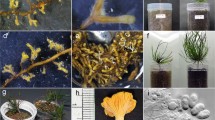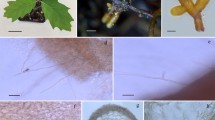Abstract
The tropical black bolete Phlebopus portentosus is highly favored in the cuisine of northern Thailand. It is suspected to form ectomycorrhizae with many host trees. Mycelium of P. portentosus isolated from a basidiome in Chiang Rai Province in 2003 grew well on modified Gamborg, modified Melin–Norkans, and Murashige and Skoog media at 30°C and at pH 4. In vitro fructification of P. portentosus on sorghum grain medium without a host plant is presented for the first time. Basidiomes emerged 3 months after inoculation on the medium, and the produced basidiospores germinated on agar, indicating the completion of its life cycle in vitro without a host. Five putative host plants (Castanopsis tribuloides, Dipterocarpus alatus, Dimocarpus longan, Pinus kesiya, and Syzygium cumini) were inoculated with mycelium on sorghum grain medium in a greenhouse to confirm its ectomycorrhizal status. Ectomycorrhizal roots were observed only on Pinus kesiya, suggesting that P. portentosus may be facultatively ectomycorrhizal. Identification of the synthesized ectomycorrhizae was confirmed by PCR amplification of ITS with a designed specific primer (HAR2A).




Similar content being viewed by others
References
Binder M, Bresinsky A (2002) Derivation of a polymorphic lineage of Gasteromycetes from boletoid ancestors. Mycologia 94:85–98
Brundrett MC, Bougher NL, Dell B, Grove T, Malajczuk N (1996) Working with mycorrhizas in forestry and agriculture. Monograph 32. ACIAR, Canberra
Danell E (1994) Cantharellus cibarius: mycorrhiza formation and ecology. Ph.D. thesis, Uppsala University, Uppsala
Danell E, Camacho FJ (1997) Successful cultivation of the golden chanterelle. Nature (Lond) 385:303
Fries N (1978) Basidiospore germination in some mycorrhiza-forming hymenomycetes. Trans Br Mycol Soc 70:319–324
Gamborg OL, Miller RA, Djima A (1968) Nutrient requirements of suspension cultures of soybean root cells. Exp Cell Res 50:151–158
Gardes M, Bruns TD (1993) ITS primers with enhanced specificity for basidiomycetes: application to the identification of mycorrhizae and rust. Mol Ecol 2:113–118
Godbout C, Fortin JA (1990) Cultural control of basidiome formation in Laccaria bicolor with container-grown white pine seedlings. Mycol Res 94:1051–1058
Hall IR, Lyon AJE, Wang Y, Sinclair L (1998) Ectomycorrhizal fungi with edible fruiting bodies. 2. Boletus edulis. Econ Bot 52:44–56
Ingold CT (1979) The nature of toadstools. Arnold, London
Ji KP, Zhang CX, Zeng Y, Liu CF, He MX, Wang WB (2007) Artificial colony and its fruiting of Phlebopus portentosus (Boletaceae) in pot. Acta Bot Yunnan 29:554–558
Kawai M (1997) Artificial ectomycorrhiza formation on roots of air-layered Pinus densiflora saplings by inoculation with Lyophyllum shimeji. Mycologia 89:228–232
Lefevre CK, Hall IR (2001) The status of truffle cultivation: a global perspective. In: Mehlenbacher SA (ed) Proceedings Vth International Congress on Hazelnut. ISHS, Leuven, pp 513–520
Marino RH, da Eira AF, Kuramae EE, Queiroz EC (2003) Morphomolecular characterization of Pleurotus ostreatus (Jacq.: Fr.) Kummer strains in relation to luminosity and temperature of fructification. Sci Agric 60:531–535
Marx DH (1969) The influence of ectotrophic mycorrhizal fungi on the resistance of pine roots to pathogenic infections. I. Antagonism of mycorrhizal fungi to root pathogenic fungi and soil bacteria. J Phytopathol 59:153–163
McLaughlin DJ (1964) Production of fruit-bodies of Suillus rubinellus in pure culture. Mycologia 56:136–138
McLaughlin DJ (1970) Environmental control of fruit-body development in Boletus rubinellus in axenic culture. Mycologia 62:307–331
Molina R, Palmer JG (1982) Isolation, maintenance, and pure culture manipulation of ectomycorrhizal fungi. In: Schenck NC (ed) Methods and principles of mycorrhizal research. American Phytopathological Society, St. Paul, pp 115–129
Ohta A (1994a) Some cultural characteristics of mycelia of a mycorrhizal fungus, Lyophyllum shimeji. Mycoscience 35:83–87
Ohta A (1994b) Production of fruit-bodies of a mycorrhizal fungus, Lyophyllum shimeji, in pure culture. Mycoscience 35:147–151
Ohta A (1997) Ability of mycorrhizal fungi to utilize starch and related substrates. Mycoscience 38:403–408
Ohta A (1998) Fruit-body production of two ectomycorrhizal fungi in the genus Hebeloma in pure culture. Mycoscience 39:15–19
Ohta A, Fujiwara N (2003) Fruit-body production of an ectomycorrhizal fungus in genus Boletus in pure culture. Mycoscience 44:295–300
Pachlewski R, Pachlewski J (1974) Studies on symbiotic properties of mycorrhizal fungi of pine (Pinus silvestris L.) with the aid of the method of mycorrhizal synthesis in pure cultures on agar. Forest Research Institute, Warsaw
Pantidou ME (1961) Carpophores of Phlebopus sulhureus in culture. Can J Bot 39:1163–1167
Pantidou ME (1962) Culture studies of Boletaceae. Carpophores of Phlebopus lignicola in culture. Can J Bot 40:1313–1319
Paolocci F, Angelini P, Cristofari E, Granetti B, Arcioni S (1995) Identification of Tuber spp. and corresponding ectomycorrhizae through molecular markers. J Sci Food Agric 69:511–517
Raeder U, Broda P (1985) Rapid preparation of DNA from filamentous fungi. Lett Appl Microbiol 1:17–20
Richardson KC, Jarret L, Finke EH (1960) Embedding in epoxy resins for ultra thin sectioning electron microscopy. Stain Technol 35:313–323
Sakamoto Y, Ando A, Tamai Y, Miura K, Yajima T (2002) Protein expressions during fruit body induction of Flammulina velutipes under reduced temperature. Mycol Res 106:222–227
Sanmee R (2004) Biodiversity, host range, and growth of edible ectomycorrhizal fungi in upper northern Thailand. Ph.D. thesis, Chiang Mai University, Chiang Mai
Sanmee R, Dell B, Lumyong P, Izumori K, Lumyong S (2003) Nutritive value of popular wild edible mushrooms from Northern Thailand. Food Chem 82:527–532
Spurr AR (1966) A low viscosity epoxy resin embedding medium for electron microscopy. J Ultrastruct Res 26:31
Stoll VS, Blanchard JS (1990) Buffers: principles and practice. In: Deutscher MP (ed) Methods in enzymology, vol 182. Guide to protein purification. Academic Press, San Diego, pp 24–38
Straatsma G, van Griensven LJLD, Bruinsma J (1986) Root influence on in vitro growth of hyphae of the mycorrhizal mushroom Cantharellus cibarius replaced by carbon dioxide. Physiol Plant 67:521–528
Taylor A, St J Hardy GE, Wood P, Burgess T (2005) Identification and pathogenicity of Botryosphaeria species associated with grapevine decline in Western Australia. Aust Plant Pathol 34:187–195
Watling R (2001) The relationships and possible distributional patterns of boletes in South-East Asia. Mycol Res 105:1440–1448
Yamanaka K, Namba K, Tajiri A (2000) Fruit body formation of Boletus reticulates in pure culture. Mycoscience 41:189–191
Acknowledgments
This project was supported by the Thailand Research Fund (Project code BGJ4580023) and the Royal Golden Jubilee Ph.D. Program (Grant No. PHD/0027/42) for Rarunee Sanmee. The authors thank Dr. Eric McKenzie, Landcare Research, Auckland, New Zealand, and Dr. Boonsom Bussaban, Department of Biology, Chiang Mai University, for their kind help in preparing the manuscript.
Author information
Authors and Affiliations
Corresponding author
About this article
Cite this article
Sanmee, R., Lumyong, P., Dell, B. et al. In vitro cultivation and fruit body formation of the black bolete, Phlebopus portentosus, a popular edible ectomycorrhizal fungus in Thailand. Mycoscience 51, 15–22 (2010). https://doi.org/10.1007/s10267-009-0010-6
Received:
Accepted:
Published:
Issue Date:
DOI: https://doi.org/10.1007/s10267-009-0010-6




